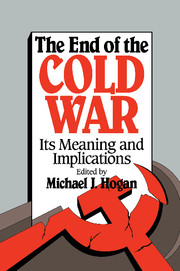Book contents
- Frontmatter
- Contents
- Preface
- The Authors
- Dedication
- 1 Introduction
- 2 An End to Which Cold War?
- 3 The Cold War, the Long Peace, and the Future
- 4 Quiet Cataclysm: Some Afterthoughts on World War III
- 5 Some Lessons from the Cold War
- 6 Nuclear Weapons and European Security during the Cold War
- 7 Victory in the Postwar Era: Despite the Cold War or Because of It?
- 8 The Wicked Witch of the West is Dead. Long Live the Wicked Witch of the East
- 9 The End and the Begining
- 10 A Balance Sheet: Lippmann, Kennan, and the Cold War
- 11 Why Did the Cold War Arise, and Why Did It End?
- 12 A View from Below
- 13 The End of the Cold War and the Middle East
- 14 The End of the Cold War in the Near East: What It Means for Historians and Policy Planners
- 15 After the Cold War: The United States, Germany, and European Security
- 16 The End of the Cold War: A Skeptical View
- 17 The End of the Cold War, the New Role for Europe, and the Decline of the United States
- 18 The Fading of the Cold War—and the Demystification of Twentieth-Century Issues
- 19 The U.S. Government, a Legacy of the Cold War
- 20 Foreign Policy, Partisan Politics, and the End of the Cold War
- 21 Beyond Bipolarity in Space and Time
- 22 A Usable Past for the Future
- Selective Bibliography
- Index
12 - A View from Below
Published online by Cambridge University Press: 18 December 2009
- Frontmatter
- Contents
- Preface
- The Authors
- Dedication
- 1 Introduction
- 2 An End to Which Cold War?
- 3 The Cold War, the Long Peace, and the Future
- 4 Quiet Cataclysm: Some Afterthoughts on World War III
- 5 Some Lessons from the Cold War
- 6 Nuclear Weapons and European Security during the Cold War
- 7 Victory in the Postwar Era: Despite the Cold War or Because of It?
- 8 The Wicked Witch of the West is Dead. Long Live the Wicked Witch of the East
- 9 The End and the Begining
- 10 A Balance Sheet: Lippmann, Kennan, and the Cold War
- 11 Why Did the Cold War Arise, and Why Did It End?
- 12 A View from Below
- 13 The End of the Cold War and the Middle East
- 14 The End of the Cold War in the Near East: What It Means for Historians and Policy Planners
- 15 After the Cold War: The United States, Germany, and European Security
- 16 The End of the Cold War: A Skeptical View
- 17 The End of the Cold War, the New Role for Europe, and the Decline of the United States
- 18 The Fading of the Cold War—and the Demystification of Twentieth-Century Issues
- 19 The U.S. Government, a Legacy of the Cold War
- 20 Foreign Policy, Partisan Politics, and the End of the Cold War
- 21 Beyond Bipolarity in Space and Time
- 22 A Usable Past for the Future
- Selective Bibliography
- Index
Summary
There have been important changes in the international order in the past several decades, but the continuities are no less significant, particularly with regard to North-South relations. Although U.S. policies toward the Third World were framed within a Cold War context, that was more a matter of doctrinal utility than of fact. The North-South conflicts, with their deep roots in the colonial era, are likely to continue as the policies of the United States and other advanced industrial powers are adapted to changing circumstances, of which the end of the Cold War is only one aspect.
By the 1970s, the United States had lost its post-World War II position of overwhelming dominance, and there was speculation about competing trading blocs (dollar, yen, European Currency Union). While it remains the leading economic power, the United States faces serious internal problems, exacerbated by policies of the past decade whose social and economic costs cannot be indefinitely deferred. At the same time, Soviet military expenditures were leveling off and internal problems were mounting, with economic stagnation and increasing pressures for an end to tyrannical rule. A few years later, the Soviet system had collapsed. The Cold War ended with the victory of what had always been the far richer and more powerful contestant. The Soviet collapse was part of a much more general economic catastrophe of the 1980s, more severe in the Third World domains of the West than in the Soviet empire. As commonly observed, the global system has become economically tripolar but militarily unipolar.
- Type
- Chapter
- Information
- The End of the Cold WarIts Meaning and Implications, pp. 137 - 150Publisher: Cambridge University PressPrint publication year: 1992
- 1
- Cited by



